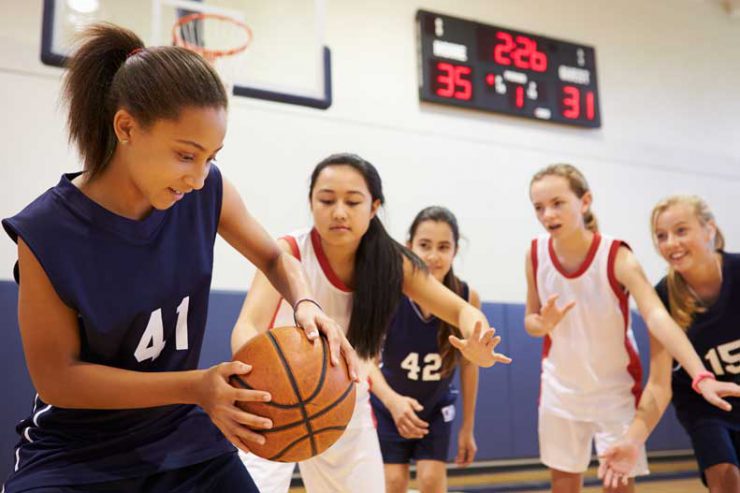Basketball players are no stranger to injury. After all, the game is extremely physical. There’s the short, quick bursts down the court. All the sudden stops and starts. And people jumping, swatting, and shoving, doing anything they can do get the ball. With all that, there’s bound to be some sprains and strains.
So, if you’re planning to play hoops at the local court, or your son or daughter is involved in a recreational league, be aware of the most common basketball injuries and how to treat them.
Similar to professional and college basketball players, high school and recreational athletes are subject to various injuries because the sport involves:
- Short, intermittent bursts of activity
- Quick stops and starts
- Physical contact
So, if you’re planning to play hoops, be aware of the most common injuries and how to treat them.
Never Miss a Beat!
Subscribe to Our HealthBeat Newsletter!
Thank you for subscribing!
You can now select the specific newsletters you'd like to receive.
You are already subscribed.
Subscribe to more newsletters in our email preference center.
Sorry, an error occurred. Please try again later.
Get Healthy Tips Sent to Your Phone!
Common Basketball Injuries
Ankle sprains in basketball
When the foot is forcibly rolled inward or outward, ligaments that hold the ankle in place can overstretch or tear, resulting in an ankle sprain.
| Ankle Sprain Symptoms | Ankle Sprain Treatment |
Pain on the overstretched portion of the ankle
|
|
RELATED: How to Wrap an Ankle or Wrist Sprain
Achilles tendonitis in basketball players
Achilles tendonitis is a common overuse injury in basketball, due to the forces placed on the tendon from jumping and landing.
The Achilles tendon is the fibrous structure that attaches the calf muscle to the heel of your foot. It allows the calf muscle to pull your heel off the ground and push forward while walking or running.
Achilles tendonitis occurs when you don’t stretch your calf muscles properly.
| Achilles Tendonitis Symptoms | Achilles Tendonitis Treatment |
A dull ache or pain in the back of the leg, just below the calf muscle
|
|
Sever’s disease is another basketball injury related to the Achilles tendon, where it begins to tear away from the heel. This type of injury is most prevalent in young basketball players.
Patellar tendonitis in basketball players
Patellar tendonitis is a common overuse injury in basketball that affects the tendon connecting the kneecap (patella) to the shin bone.
The patellar tendon, along with the quadriceps muscle and tendon, provides the strength for straightening out the knee.
Patellar tendonitis occurs when repeated stress is placed on the patellar tendon. The stress results in tiny tears in the tendon, which the body attempts to repair.
But, as the tears in the tendon become more numerous, the body can’t keep up, causing the inflammation in the tendon to worsen.
| Patellar Tendonitis Symptoms | Patellar Tendonitis Treatment |
Pain directly over the patellar tendon
|
|
Muscle strains in basketball players
Muscle strains, or muscle pulls, occur when an athlete stretches the muscle beyond its normal limit, or when a load is placed on the muscle and it is not strong enough to counteract. This results in a strain or tear of the muscle fibers.
A muscle strain can occur in any muscle, and can result from physical activity without proper stretches and warm-ups beforehand.
| Muscle Strain Symptoms | Muscle Strain Treatment |
Sharp pain in the muscle
|
|
Muscle strains are diagnosed by:
- Obtaining a thorough history of the injury
- Palpation of the affected area to detect pain and defects in the muscle
- Strength and flexibility testing
- An MRI (on more serious strains) to determine the extent of the tear
ACL tears from basketball
The anterior cruciate ligament (ACL) is the primary restraint that limits how far the shin bone (tibia) slides forward in relation to the thigh bone (femur). When the ACL tears and that restraint no longer exists, the knee becomes unstable and may unpredictably buckle or give way.
A common knee injury in basketball, the ACL may suddenly tear without warning when an individual:
- Decelerates
- Cuts to the side
- Lands awkwardly
| ACL Tear Symptoms | ACL Tear Treatment |
An audible “pop” at the moment of injury
|
Treatment may be surgical or non-surgical, depending on your desired lifestyle. The question is not so much your level of activity in the past, but the expectations for the future.
|
Finger injuries from basketball
Finger injuries range from simple cuts to bone, tendon, or ligament damage. X-rays may be taken to confirm a fracture.
If not properly treated, finger injuries can lead to deformity and permanent loss of function.
| Finger Injury Symptoms | Finger Injury Treatment |
Pain over the injury site
|
|
For athletes who have experienced sports-related injuries, UPMC Sports Medicine‘s orthopaedic surgeons, board-certified athletic trainers, and physical therapists will help to speed recovery and restore function. Call 1-855-93-SPORT (77678) to schedule an appointment or visit our website.
About Sports Medicine
An athletic lifestyle carries the potential for injury. Whether you’re an elite athlete or a weekend warrior, UPMC Sports Medicine can help. If you are looking to prevent, treat, or rehabilitate a sports injury, our multidisciplinary team of experts can help you get back into the game. If you are seeking to improve your athletic performance, we can work with you to meet your goals. We serve athletes and active people of all ages and experience levels. Our goal is to help you keep doing what you love. Visit our website to find a specialist near you.
